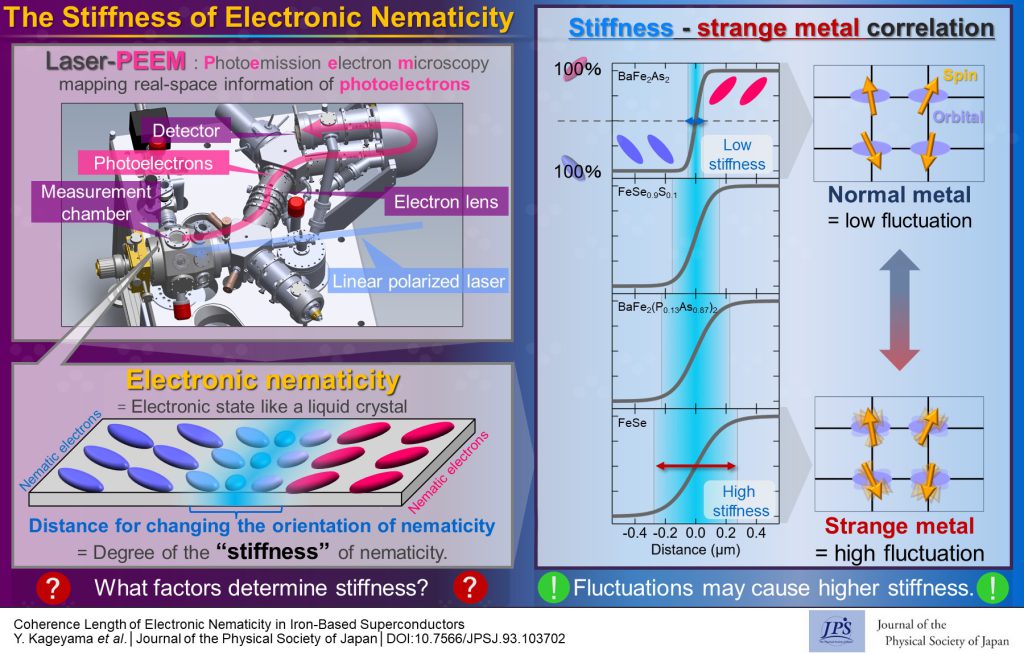The Stiffness of Electronic Nematicity
© The Physical Society of Japan
This article is on
Coherence Length of Electronic Nematicity in Iron-Based Superconductors
(JPSJ Editors' Choice)
J. Phys. Soc. Jpn.
93,
103702
(2024)
.
Using laser-excited photoelectron emission microscope (laser-PEEM) we found that the nematic stiffness in iron-based superconductors significantly increases as the systems become strange metals, suggesting that spin–orbital fluctuations enhance the stiffness of electronic nematicity.

In recent years, a novel electronic state called the “electronic nematic phase” has attracted much attention. The electronic nematic phase is characterized by rotational symmetry breaking driven by electronic degrees of freedom, such as spins and orbitals, and behaves like a liquid crystal. Iron-based superconductors (IBSs), which are unconventional high-temperature superconductors, are prominent candidates in which an electronic nematic phase appears at low temperatures.
The electronic nematic phase in IBSs breaks the four-fold rotational symmetry of the lattice, and the electronic state has two-fold rotational symmetry. In this case, two energetically equivalent states with different preferred orientations can coexist in real space. This real-space structure, called the domain structure, often provides essential information for understanding the electronic states. In some IBSs, novel domain structures called mesoscopic nematicity waves (MNW) have been observed in which the domains behave like sinusoidal waves with mesoscopic wavelengths of approximately 500 nm. This phenomenon can be interpreted as the boundary between two neighboring domains becoming very long. The length of the domain boundary implies how hard it is to change from one domain to another, indicating the degree of the “stiffness” of the electronic nematicity. From this perspective, the MNW with a thick domain wall possesses very high stiffness. However, the origin of the high stiffness has not yet been elucidated.
We used a laser-PEEM to observe the domains in BaFe2As2 and FeSe0.9S0.1 and compared their stiffness with those of FeSe and BaFe2(As0.87P0.13)2 studied previously. We found that the length of the domain boundary varies in different materials and is related to the “strange metal” behavior of the transport properties.
The electrical resistivity of normal metals is proportional to the square of the temperature, T. In strange metals, however, the temperature dependence of the resistivity deviates from this standard T2 dependence and exhibits T-linear behavior owing to spin–orbital fluctuations. Thus, we fitted the electrical resistivity above the nematic phase transition temperature with r = r0 + ATn, and the deviation of the temperature exponent n from 2 was used as the degree of unusual metallicity. By comparing the value of n with the thickness of the domain boundaries, we found that the stiffness increased as the material approached a strange metal. This suggests that the stiffness of the nematicity can be enhanced by the spin–orbital fluctuations responsible for strange-metal behavior. Our results provide important information for understanding and controlling electronic nematic phases.
(Written by Y. Kageyama and T. Shibauchi on behalf of all authors)
Coherence Length of Electronic Nematicity in Iron-Based Superconductors
(JPSJ Editors' Choice)
J. Phys. Soc. Jpn.
93,
103702
(2024)
.
Share this topic
Fields
Related Articles
-
Higher-Order Topological Phases in Magnetic Materials with Breathing Pyrochlore Structures
Electronic structure and electrical properties of surfaces and nanostructures
Magnetic properties in condensed matter
Mathematical methods, classical and quantum physics, relativity, gravitation, numerical simulation, computational modeling
2025-4-7
A simple example of a higher-order topological phase, in which the symmetry decreases step-by-step from the bulk to the corner, is realized in a magnetic system with a pyrochlore structure and is characterized by a series of quantized Berry phases defined for the bulk, surface, and edge.
-
A Unified Theory of Topological Hall Effect
Electronic transport in condensed matter
2025-3-6
This paper presents a unified theoretical description for the topological Hall effect, covering the entire region from strong- to weak-coupling, extending its picture beyond the Berry phase.
-
Excitonic Insulators: Challenges in Realizing a Theoretically Predicted State of Matter
Electron states in condensed matter
Electronic transport in condensed matter
2025-3-3
The realization of an excitonic insulator can help in the establishment of a new electronic state in condensed matter physics, one that has the potential to exhibit novel electric, magnetic, and optical responses beyond those of conventional materials.
-
Triangular Lattice Magnet GdGa2: Spin Cycloids and Skyrmions
Cross-disciplinary physics and related areas of science and technology
Electronic transport in condensed matter
Magnetic properties in condensed matter
2025-2-3
Careful measurements were conducted on the hexagonal magnet GdGa2 to reveal the experimental signatures of ultrasmall spin cycloids and of a potential Néel-type skyrmion lattice phase induced by a magnetic field.
-
Shaping the Future of Materials Science with Tanabe–Sugano Diagrams
Dielectric, optical, and other properties in condensed matter
Electron states in condensed matter
Electronic structure and electrical properties of surfaces and nanostructures
Magnetic properties in condensed matter
2025-1-21
This special collection published in the Journal of the Physical Society of Japan celebrates 70 Years of Tanabe–Sugano Diagrams, highlighting their continued role in advancing materials with transition metals.




